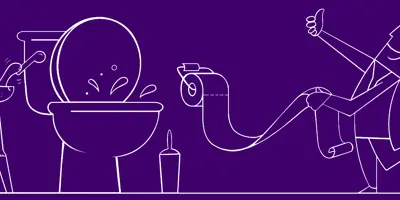1 person found this helpful

Clear, cloudy, yellow: we’ve all found ourselves wondering ‘what colour should healthy urine be’? It’s important to pay attention to urine colour and its meaning as it can provide valuable information about your health. By learning about your urine colour meaning, you can discover just how hydrated you are, and spot the signs of infection.
Find out what is a healthy colour of urine, and what the appearance of your pee can tell you. Don’t forget to check our healthy urine colour chart so you can see how yours matches up!
Understanding and using a healthy urine colour chart
Medical bodies like the NHS use a healthy urine colour chart to help us determine whether we’re hydrated and well. Here are a few facts about using a urine colour chart and its meaning1:
- Usually, these charts start with a very pale colour as number one, and the colour gets progressively darker yellow as the numbers increase to eight.
- With these colour charts, you can work out the meaning of urine colour by matching it against the shades.
- If your pee is darker than the optimum, lighter shades on the chart, then you need to increase your fluid intake.
- If your urine is at the darkest end of the spectrum, you may need to seek medical attention.
Understanding what a healthy pee colour looks like
Using the healthy urine colour chart, you can quickly discover the answer to questions such as, ‘what colour should healthy urine be?’ It should be noted that understanding the pee colour meaning is essential as it can offer insights into your individual's overall health and wellness.
To make it easier, here is a quick guide to healthy urine colour2:
- Healthy pee is clear or very pale yellow. These are the first two colours shown on our healthy urine colour chart.
- The yellow colour mainly comes from a natural compound called urobilin (or urochrome, as it’s also known). When the body breaks down red blood cells that it no longer needs, it produces urobilin.
- Urine is primarily water – 90 to 95 per cent of urine is made up of water. If you’re well hydrated, the water content of your urine will be greater and therefore will dilute the yellow colour of urobilin, making it paler.
What else can affect the urine colour and meaning of different colours?
Many people wonder, "what's the normal colour of urine?" as it can vary depending on an individual's hydration levels and overall health. Sometimes urine colour can be noticeably different, without being caused by dehydration or infection.
Here are a couple of noticeable changes which could occur because certain medications, vitamin supplements and even food have affected what would otherwise be a healthy colour of urine2:
- Neon yellow. A pale yellow is normal, but it can also look very bright – like a neon yellow. This is often down to supplements containing the B vitamins, in particular vitamin B12. Because these kinds of vitamins are water soluble, your body removes any excess B vitamins through urine.
- Green. You might find green urine quite alarming, but the answer could be simple – your diet, such as green food colouring or asparagus. Dyes used for medical tests like kidney investigations, or in certain medications, like propofol that’s used during anaesthesia, can also cause green urine. In those cases, the green colour will only be temporary. However, green-tinged pee can be linked to a bacterial urine infection caused by pseudomonas, so keep an eye on it and seek medical advice to be sure.
Try a toilet paper that’s cushiony and strong, like Cushelle, which is so thick and absorbent, you’ll often find just one sheet is enough.
Signs of dehydration
Clear and straw-coloured is a healthy pee colour in terms of hydration. This usually isn’t the case when your pee is darker. Not ingesting enough fluids could lead to spotting a ‘Brownish’ or ‘Orange’ pee colour like on our urine colour chart, and meaning you’re dehydrated. Other signs of dehydration other than a non-healthy urine colour are3:
- Thirst
- Dry mouth, lips, or eyes
- Headaches
- Constipation
- Dizziness
- Lack of concentration
- Tiredness
- Strong-smelling urine
Aim to sip around two litres of water at regular intervals throughout the day to maintain a healthy pee colour and optimum hydration levels. All of us need to stay well hydrated, but some groups are particularly at risk of dehydration. These include3:
- Older people (as your thirst response drops as you age)
- Babies and infants (because of their low body weight)
- Those with long-term health conditions (like diabetes)
- Athletes (as they lose fluids through sweating)
It’s also important to stay hydrated when you’ve got a cold, or if you’re suffering from diarrhoea, as you’ll be losing more fluids than usual.
It’s a good idea to introduce children to the meanings of urine colour from potty training onwards, so that they can spot the signs of dehydration early – especially when they’re running around in hot weather – and get a drink of water.
Signs of infection
The meaning of urine colour can also be related to infection, particularly if your pee is cloudy. Urinary tract infections (UTIs) can affect your bladder, kidneys, or urethra. Common symptoms of a UTI include4:
- Peeing more often than usual
- Needing to pee suddenly
- Smelly urine
- Cloudy urine
- Burning sensation or pain when peeing
- Feeling unwell
- Tiredness
- Pain in the lower tummy
- In older people, changes in behaviour like agitation or confusion
Mild UTIs often pass within a few days without treatment, and you’ll soon be back to a healthy urine colour. You should contact your doctor, however, in the following cases4:
- You’re male/pregnant/a child/elderly
- It’s your first UTI
- There’s blood in your pee
- Symptoms don’t improve in a few days, or return after treatment
Take steps to hygiene precautions to prevent getting a UTI and get in touch with your GP if you think you might have a UTI.
If you have a UTI or it’s uncomfortable down there, use a good quality, soft toilet paper, like Cushelle, for comfort on every visit to the loo.
Urine colour meaning: when to speak to a doctor
If you’re ever unsure or worried, contact your doctor. But there are also certain warning signs that should always be checked out. See your doctor if your urine is4:
- Orange. This could be dehydration or food dye, but it could also be a sign of a liver or bile duct condition.
- Pink or reddish. This could be due to eating blueberries, rhubarb, or beetroot, but there could be blood in your urine – a possible sign of prostate problems, mercury/lead poisoning, kidney disease, tumours, or a UTI.
- Brown. This could also just be down to diet, but could also indicate dehydration, or a sign of liver disease – drink more water, and if it persists, contact your doctor.
Learning about the colours of urine and their meaning is important as it can help identify any potential health problems that you may be experiencing. However, now that you know all about the urine colour chart and meaning behind the different shades of pee, you can better keep tabs on your health and hydration.
Sources:
1 Urine Analysis Tool, University Hospitals Birmingham, NHS [PDF]
2 DR J. McGratten, ‘What the colour of your wee says about your health’, NetDoctor; 2020
Related articles
What is a normal stool colour? A guide with poo chart
What is a normal stool colour? Discover everything you didn’t know you needed to know about poo using our stool chart and handy guide.

How to poo properly: 4 tips for the correct way to poop
We've put together this handy guide packed full of tips for happier, more healthy bowel movement. Read on for our 4 tips for how to poo properly!

Why do men pee while standing?
Being able to urinate standing can come with unexpected challenges. Wondering how to pee properly? Men: here’s some advice on urinating; sitting or standing.

10 feminine hygiene tips you may not know
Need feminine hygiene advice for yourself or your child? This is a feminine-care resource for women of all ages. Click here to find out more.

Dry eyes: causes and symptoms
Discover what can cause dry eyes and dry eye symptoms. Use our easy-to-follow guide to fight back, and help to ease and avoid dry irritated eyes in the future.

9 toilet hygiene rules
How can you ensure your family follows good hygiene in the loo? Check out our 10 toilet hygiene rules, and download our handy toilet rules sign, here.



